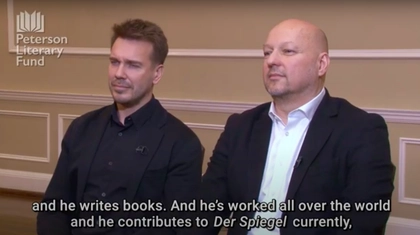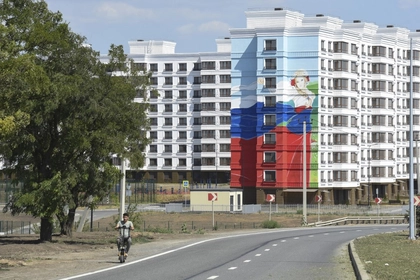A glider bomb dropped by a strike jet from air space across the border in Russia hit a nursing home in Ukraine’s north-central Sumy region on Thursday, killing 1 resident, injuring 13, and forcing the evacuation of 147 elderly living at a care center.
The semi-guided weapon was by firepower standards in the Russo-Ukrainian War relatively small, probably with no more than 250 kilograms of high explosive. It struck the roof of the Sumy Geriatric Pensionate for Veterans of War and Labor (SGPVW), a state-run institution serving elderly unable to care for themselves fully, with limited family support, or both.
JOIN US ON TELEGRAM
Follow our coverage of the war on the @Kyivpost_official.
The Soviet-era residential SGPVW complex is located in Sumy city’s northwestern suburbs. In peacetime, the facility is a dilapidated but leafy place typical of provincial Ukrainian social institutions. Adjacent to the nursing home, and also built before Ukraine became independent, are a cardiological hospital, a children’s hospital, a general hospital, two schools and a pastoral green space with a lake and wooded trails called Veteran’s Park.


Ukrainian Naivety is Both Good and Bad
The bomb detonated at about 3 p.m., demolishing the building’s attic and roof, and rubbling portions of the top floor. Most exterior windows were blown out, as were almost all interior windows on the fifth floor. The explosion shut down power, cut water and froze elevators. Until dust settled, it wasn’t possible to see more than a few meters, eyewitnesses told media.
First responders, many from the health facilities next door, swarmed the scene. Of the 221 men and women known to have been boarding in nursing home struck by the bomb, at least half were too shocked or mobility-limited to negotiate stairs. Retirement home staff, firemen, doctors and nurses linked arms or grabbed blankets to carry people downstairs.
In a state-run facility like the SGPVW a prospective resident usually must show no means of support beyond a personal pension, and completion of a full career in a state-certified profession. Frequently they are former factory workers retired after three decades of tough, Soviet-era labor.
Many residents were frail, and the bomb blast potentially threatened all with worsened health. Wheelchairs were left upstairs. Mass casualty processing was on the front lawn. There were cots for some, but others had to lie on blankets on the ground.
One 78-year-old woman died from injuries, in hospital. Some injured on Thursday still were in serious condition, an Emergency Situations Ministry Friday statement said. It was not clear where survivors would now live, acting Sumy Mayor Artyem Kobzar told reporters.
“All the windows are completely broken, we climbed from the first floor to the last, it is impossible for anyone to be anywhere in the building. The enemy is hitting people who have nothing to do with the war. They are just infirm people,” Kobzar said on Thursday.

“A home for the elderly was hit,” a visibly charged President Volodymyr Zelensky said in a Thursday evening statement. “Rescue work is in progress and emergency responders are checking to see if people are trapped in the rubble… There is no way Russia could not have known that this elderly care home was not a military base. Not a military site.”
The Ukrainian leader went on to accuse the Kremlin of dropping 90-100 guided bombs on mostly civilian targets daily, and of intentionally attempting to terrorize Ukrainian civilians. Russia insists it only hits military targets.
“The Russian Federation’s operational-tactical aviation and missile forces carried out strikes on Ukrainian army assembly areas of concentration in the Sumy region,” the Russian Defense Ministry daily situation report said of operations in the Sumy sector. According to that Friday morning Kremlin statement, Russian air strikes in Sumy region hit elements of nine Ukrainian army combat brigades and three territorial defense brigades. Civilian targets weren’t mentioned.
Massed Russian strikes against civilian targets likely were first employed by post-Soviet Russia against Chechen insurgents in 2004-05. In 2015 in Syria the Russian Air Force reduced Aleppo, a city mostly inhabited by people opposing a pro-Moscow regime in Damascus, to rubble.
Those bombardments’ main engine was Russia’s modern Su-34 attack jet. Following the Kremlin’s 2022 invasion of Ukraine, Russian engineers developed kits converting unguided bombs of the type used in Syria, into guided glider bombs. The weapon is not absolutely precise but, dropped in groups, with some weighing three tons, guided glider bombs have become a go-to for Russian operations officers planning saturation attacks. Russian pilots like the bombs because they launch from outside the range of Ukrainian anti-aircraft missiles.
According to the local Sumy Go news platform, the once fairly sleepy Sumy region along the Russian border is seeing nightly cross-border strikes, many of them glider bombs. Overnight Thursday-Friday the Russian military hit the Sumy region territory 38 times. Eight attacks were bombs at least as powerful as the one that hit the nursing home, those reports citing military data said.
Ukrainian authorities have recorded a similar spike in Russian long-range drone and missile use around Sumy region. In the past, for years, those self-guiding weapons had mostly passed overhead and headed elsewhere, frequently for more industrialized Kyiv and Kharkiv.

On Sept. 17, at least two dozen Russian kamikaze drones struck around Sumy city, local officials said, targeting power grid, heating and water works infrastructure. Kobzar said although “most” of the robot aircraft were shot down, hits cut off water pressure and halted trolley service in Sumy for more than 24 hours.
Russian ballistic missile strikes the same day targeted key energy infrastructure across the Sumy region, the Ukrainian milblogger Anatoly Herashchenko reported.
Complex Russian strikes using a mix of bombs, missiles and drones against Sumy region infrastructure and civilians have taken place at roughly five-day intervals since Ukraine invaded Russia in mid-August, Kyiv Post research found.
Widely read Ukrainian milblogger Kyrylo Sazonov in an emotional Thursday Telegram post on the Sept. 17 missile strikes against Sumy summed up Ukrainian frustration and anger, both against Russian attacks and toward a White House banning Kyiv from using long-range American weapons to hit back at Russia, so places like Sumy won’t be bombarded.
“The UN probably doesn’t even notice such news. But we do. We remember it. Together with the sluggish reaction of all international organizations and our partners, who forbid us from hitting back. I send a big ‘hello’ to the Biden Administration and the entire Democratic Party of the United States. A paradoxical situation. They (the US) invest so much effort and emotion to invest in the fight against corruption in Ukraine, in the fight for gender equality, in the fight against smoking. And then they calmly ignore it when Ukrainians are killed daily by bombs and missiles,” Sazonov said.
You can also highlight the text and press Ctrl + Enter






